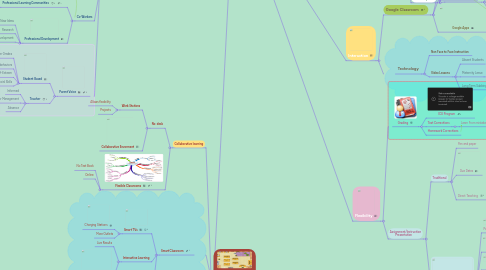
1. Collaboration
1.1. Team Work
1.1.1. Peer Teaching
1.1.1.1. Making Connections
1.1.1.1.1. Deeper Connection
1.1.1.1.2. Higher Level of Thinking
1.1.1.1.3. Less Direct Instruction
1.1.1.2. Learning from misakes
1.1.2. Project Based Learning
1.1.3. Sharing Ideas
1.1.3.1. Coming together
1.1.3.2. Brainstorming
1.1.3.3. New outlook
1.1.3.4. Fresh Ideas/Out of the Box
1.2. Co-Workers
1.2.1. Professional Learning Communities
1.2.1.1. Open Minded
1.2.1.2. Opinions vs Facts
1.2.1.3. Common Planning Time
1.2.2. Professional Development
1.2.2.1. New Ideas
1.2.2.2. Research
1.2.2.3. Development
1.3. Parent Voice
1.3.1. Student Based
1.3.1.1. Higher Grades
1.3.1.1.1. Tutoring
1.3.1.1.2. Guidance
1.3.1.2. Proper behaviors
1.3.1.3. Higher Self-Esteem
1.3.1.4. Social Skills
1.3.2. Teacher
1.3.2.1. Informed
1.3.2.2. Behavior Management
1.3.2.3. Absence
2. Classroom Layout
2.1. Collaborative learning
2.1.1. No desk
2.1.1.1. Work Stations
2.1.1.1.1. Allows flexibility
2.1.1.1.2. Projects
2.1.1.2. Collaborative Envorment
2.1.2. Flexible Classrooms
2.1.2.1. No Text Book
2.1.2.2. Online
2.2. Smart Classroom
2.2.1. Smart TVs
2.2.1.1. Charging Stations
2.2.1.2. More Outlets
2.2.2. Interactive Learning
2.2.2.1. Live Results
2.2.2.2. Live Feedback
2.2.3. IPad Intergration
2.2.3.1. Blended Inviorment
2.3. Flexible Seating
2.3.1. Non Standard Desk
2.3.1.1. Rolling Chairs
2.3.1.2. Aerobic Ball
2.3.1.3. beanbags
2.3.1.4. Stools
2.3.2. No Assigned Seating Chart
2.3.2.1. Creativity
2.3.2.2. Decision Making
3. Community
3.1. Local Businesses
3.1.1. Support Schools
3.1.1.1. Sponsorship
3.1.1.2. Donations
3.1.1.3. Scholarships
3.1.1.4. Support
3.1.1.4.1. Athletic Events
3.1.1.4.2. Academic Events
3.1.2. Internships
3.1.2.1. Life Lessons
3.1.2.2. Practice
3.1.3. Jobs
3.1.3.1. Skills
3.1.3.2. Education
3.1.3.3. Opportunities
3.2. Partnerships
3.2.1. Maximizing Resources
3.2.2. Volunteers
3.2.3. Reinforcing Social Skills
3.2.3.1. Correct Behaviors
3.2.3.2. Manors
3.2.3.3. Respect
4. Interaction
4.1. Google Classroom
4.1.1. Organization
4.1.2. Enhanced Communication
4.1.3. Google Apps
4.1.3.1. Docs
4.1.3.2. Slides
4.1.3.3. Sheets
4.1.3.4. Sites
4.1.3.4.1. Classroom Website
4.2. Technology
4.2.1. Non Face to Face Instruction
4.2.2. Video Lessons
4.2.2.1. Absent Students
4.2.2.2. Maternity Leave
4.2.2.2.1. Meaningful Subject Matter Taught
4.2.2.2.2. No Time Wasted
4.2.2.3. Long Term Subbing
5. Flexibility
5.1. Grading
5.1.1. ICU Program
5.1.2. Test Corrections
5.1.2.1. Learn From mistakes
5.1.3. Homework Corrections
5.2. Assignment/Instruction Presentation
5.2.1. Traditional
5.2.1.1. Pen and paper
5.2.1.2. Due Dates
5.2.1.3. Direct Teaching
5.2.1.3.1. Note Taking
5.2.1.3.2. Black and White
5.2.2. 21st Century
5.2.2.1. Power Points
5.2.2.2. Smart Note Book
5.2.2.3. Drop Box
5.2.2.4. Flexible Due Dates
5.2.2.5. Less Direct Instruction
5.2.2.5.1. Student Lead
5.2.2.5.2. Technology Driven
5.2.2.5.3. Open Ended
